Study on the Preparation and Properties of Thermally Conductive Semi-Aromatic Heat-Resistant PA5T-CO-10T/ Hexagonal Boron Nitride Composites
Abstract
1. Introduction
2. Materials and Methods
2.1. Materials
2.2. The Synthesis of PA5T-CO-10T
2.3. Surface Treatment of h-BN
2.4. Preparation of PA5T-CO-10T/BN
2.5. Characterization
2.5.1. Nuclear Magnetic Resonance Carbon Spectrometer (13C-NMR) Test
2.5.2. Thermogravimetric Test
2.5.3. Differential Scanning Calorimetry (DSC) Test
2.5.4. Fourier Transform Infrared Spectroscopy (FTIR) Test
2.5.5. SEM Test
2.5.6. Thermal Conductivity Test
2.5.7. Rotational Rheometer Test
2.5.8. X-Ray Diffractometer (XRD) Test
3. Results and Discussion
3.1. 13C-NMR Analysis of PA5T and PA5T-CO-10T
3.2. FTIR Analysis
3.3. SEM Analysis
3.4. Thermal Performance Analysis
3.5. Thermal Conductivity Analysis
3.6. Rotational Rheological Test Analysis
3.7. XRD Analysis
4. Conclusions
Author Contributions
Funding
Institutional Review Board Statement
Data Availability Statement
Conflicts of Interest
References
- Zhang, G.; Yan, G.-M.; Yu, T.; Lu, J.-H.; Huang, X.; Wang, X.-J.; Yang, J. Semiaromatic Polyamides Containing Carboxyl Unit: Synthesis and Properties. Ind. Eng. Chem. Res. 2017, 56, 9275–9284. [Google Scholar] [CrossRef]
- Yan, G.-M.; Wang, H.; Li, D.-S.; Lu, H.-R.; Liu, S.-L.; Yang, J.; Zhang, G. Design of recyclable, fast-responsive and high temperature shape memory semi-aromatic polyamide. Polymer 2021, 216, 123427. [Google Scholar] [CrossRef]
- Ai, T.; Feng, W.; Zou, G.; Ren, Z.; Wang, P.; Ji, J.; Zhang, W. High-performances biobased semi-aromatic polyamide10Tcopolymerized with silicone monomers. J. Appl. Polym. Sci. 2020, 138, 50266. [Google Scholar] [CrossRef]
- Feng, W.; Zou, G.; Ding, Y.; Ai, T.; Wang, P.; Ren, Z.; Ji, J. Effect of Aliphatic Diacid Chain Length on Properties of Semiaromatic Copolyamides Based on PA10T and Their Theoretical Study. Ind. Eng. Chem. Res. 2019, 58, 7217–7226. [Google Scholar] [CrossRef]
- Yang, S.H.; Fu, P.; Liu, M.Y.; Wang, Y.D.; Zhang, Y.C.; Zhao, Q.X. Synthesis, characterization of polytridecamethylene 2,6-naphthalamide as semiaromatic polyamide containing naphthalene-ring. Express Polym. Lett. 2010, 4, 442–449. [Google Scholar] [CrossRef]
- Feng, J. Failure Analysis of Rheocast Cylinder Head Covers of Hypereutectic Al–Si Alloys. J. Fail. Anal. Prev. 2020, 21, 488–493. [Google Scholar] [CrossRef]
- Yang, H.; Yang, K.; Mai, J.; Jiang, S.; Jiang, Z. Synthesis and Application of Semi-aromatic Heat-resistant Nylon PA6T/10T. Engi-Neering Plast. Appl. 2019, 18, 373–408. [Google Scholar] [CrossRef]
- Altintas, O.; Romaire, J.P.; Perkins, D.L.; Sun, T.; Wang, L.; Patel, N.; Callen, N.M.; Burns, A.B.; Gopinadhan, M. Molecular-Level Control of Thermal and Morphological Transitions in Semi-Aromatic Polyamides by Cu(I)-Catalyzed Azide–Alkyne Click Polymerization. Macromolecules 2023, 56, 2637–2650. [Google Scholar] [CrossRef]
- Shen, T.; Zhang, B.; Wang, Y.; Yang, P.; Li, M.; Hu, R.; Guo, K.; Chen, K.; Zhu, N.; Wang, L.; et al. Production of 100% bio-based semi-aromatic nylon by aerobic oxidation of 5-hydroxymethylfurfural to 2,5-furandicarboxylic acid with bio aliphatic diamine. Chem. Eng. J. 2022, 437, 135361. [Google Scholar] [CrossRef]
- Xie, S.; Yang, J.; Wang, X.; Yang, J. Synthesis of fully biobased semi-aromatic furan polyamides with high performance through facile green synthesis process. Eur. Polym. J. 2022, 162, 110932. [Google Scholar] [CrossRef]
- Zhang, G.; Yan, G.-M.; Ren, H.-H.; Li, Y.; Wang, X.-J.; Yang, J. Effects of a trans- or cis-cyclohexane unit on the thermal and rheological properties of semi-aromatic polyamides. Polym. Chem. 2016, 7, 44–53. [Google Scholar] [CrossRef]
- Chapman, S.K.; Glant, S.K. Antiproliferative effects of inhibitors of polyamine synthesis in tumors of neural origin. J. Pharm. Sci. 2010, 69, 733–735. [Google Scholar] [CrossRef]
- Cao, J.-P.; Zhao, J.; Zhao, X.; You, F.; Yu, H.; Hu, G.-H.; Dang, Z.-M. High thermal conductivity and high electrical resistivity of poly(vinylidene fluoride)/polystyrene blends by controlling the localization of hybrid fillers. Compos. Sci. Technol. 2013, 89, 142–148. [Google Scholar] [CrossRef]
- Yu, R.-L.; Zhang, L.-S.; Feng, Y.-H.; Zhang, R.-Y.; Zhu, J. Improvement in toughness of polylactide by melt blending with bio-based poly(ester)urethane. Chin. J. Polym. Sci. 2014, 32, 1099–1110. [Google Scholar] [CrossRef]
- Miao, X.; Wang, C.; Liao, T.; Ju, S.; Zha, J.; Wang, W.; Liu, J.; Zhang, Y.; Ren, Q.; Xu, F.; et al. Novel magnetocaloric composites with outstanding thermal conductivity and mechanical properties boosted by continuous Cu network. Acta Mater. 2023, 242, 118453. [Google Scholar] [CrossRef]
- Liu, L.; Feng, Y.P.; Shen, Z.X. Structural and electronic properties of h-BN. Phys. Rev. B 2003, 68, 104102. [Google Scholar] [CrossRef]
- Chen, C.; Guo, Z.; Ji, L.; Gao, H.; Hao, J.; Ye, A. Fabrication of Al-Cu Composite Reinforced with BN by Powder Liquid-Phase Forging. Rare Met. Mater. Eng. 2016, 45, 165–170. Available online: https://www.researchgate.net/publication/299392002_Fabrication_of_Al-Cu_composite_reinforced_with_BN_by_powder_liquid-phase_forginghtm (accessed on 18 February 2025).
- Wang, Z.; Zhang, K.; Zhang, B.; Tong, Z.; Mao, S.; Bai, H.; Lu, Y. Ultrafast battery heat dissipation enabled by highly ordered and interconnected hexagonal boron nitride thermal conductive composites. Green Energy Environ. 2022, 7, 1401–1410. [Google Scholar] [CrossRef]
- Zhao, C.B.; Xu, S.C.; Qin, Y.F.; Su, L.; Yang, X.J. Thermal Conductivity Cyanate Ester Resin Composites Filled with Boron Nitride. Adv. Mater. Res. 2014, 893, 259–262. [Google Scholar] [CrossRef]
- Zhang, Y.M.; Wang, H.B.; He, X.D.; Han, J.C.; Du, S.Y. Fabrication of hexagonal boron nitride based ceramics by combustion synthesis. Trans. Nonferrous Met. Soc. China 2001, 11, 76–79. [Google Scholar] [CrossRef]
- Ji, Y.; Han, S.-D.; Wu, H.; Guo, S.-Y.; Zhang, F.-S.; Qiu, J.-H. Understanding the Thermal Impedance of Silicone Rubber/Hexagonal Boron Nitride Composites as Thermal Interface Materials. Chin. J. Polym. Sci. 2023, 42, 352–363. [Google Scholar] [CrossRef]
- Chen, H.; Wang, Y.; Nan, Y.; Wang, X.; Yue, X.; Zhang, Y.; Fan, H. Effects of BN on the Mechanical and Thermal Properties of PP/BN Composites. J. Wuhan Univ. Technol. Sci. Ed. 2024, 39, 345–352. [Google Scholar] [CrossRef]
- Liu, B.; Zhang, S.; Ma, L.; Wu, Y.; Li, C.; Wu, Z.; Bian, X.; Yan, W. Synthesis, characterization and crystallization kinetics of a bio-based, heat-resistance nylon 5T/10T. RSC Adv. 2023, 13, 17874–17882. [Google Scholar] [CrossRef] [PubMed]
- ISO 22007; Plastics-Determination of Thermal Conductivity and Thermal Diffusivity. ISO Copyright Office City: Geneva, Switzerland, 2024.
- Kint, D.P.R.; Muñoz-Guerra, S. Modification of the thermal properties and crystallization behaviour of poly(ethylene terephthalate) by copolymerization. Polym. Int. 2003, 52, 321–336. [Google Scholar] [CrossRef]
- Meng, C.; Liu, X. Study on reaction kinetics of bio-based semi-aromatic high-temperature polyamide PA5T/56. Polym. Bull. 2022, 80, 2503–2514. [Google Scholar] [CrossRef]
- Andrews, L.; Wang, X. Infrared Spectrum of the Novel Electron-Deficient BH4 Radical in Solid Neon. J. Am. Chem. Soc. 2002, 124, 7280–7281. [Google Scholar] [CrossRef]
- Luo, F.-H.; Dong, Z.-T.; Chen, G.-H.; Ma, C.; Wang, H.-Y. Preparation of PVA/GO/h-BN Janus Film with High Thermal Conductivity and Excellent Flexibility via a Density Deposition Self-assembly Method. Chin. J. Polym. Sci. 2024, 42, 1217–1226. [Google Scholar] [CrossRef]
- Gu, J.; Zhang, Q.; Dang, J.; Xie, C. Thermal conductivity epoxy resin composites filled with boron nitride. Polym. Adv. Technol. 2012, 23, 1025–1028. [Google Scholar] [CrossRef]
- Liang, Q.; Xiu, Y.; Lin, W.; Moon, K.-S.; Wong, C.P. Epoxy/h-BN composites for thermally conductive underfill material. In Proceedings of the 2009 IEEE 59th Electronic Components and Technology Conference (ECTC 2009), San Diego, CA, USA, 26–29 May 2009; pp. 437–440. [Google Scholar]
- Zhang, Z.-W.; Zheng, W.-T.; Jiang, Q. Hydrogen adsorption on Ce/BNNT systems: A DFT study. Int. J. Hydrogen Energy 2012, 37, 5090–5099. [Google Scholar] [CrossRef]
- Cao, M.; Zhang, C.; He, B.; Huang, M.; Jiang, S. Synthesis of 2,5-furandicarboxylic acid-based heat-resistant polyamides under existing industrialization process. Macromol. Res. 2017, 25, 722–729. [Google Scholar] [CrossRef]
- Tiwari, R.; Butola, B.S.; Joshi, M. Effect of Ethoxy functionalized hexagonal boron nitride on h-BN/TPU thermoplastic polyurethane nanocomposite and its thermal properties. Polym. Eng. Sci. 2025, 65, 576–590. [Google Scholar] [CrossRef]
- Ma, T.; Zhao, Y.; Ruan, K.; Liu, X.; Zhang, J.; Guo, Y.; Yang, X.; Kong, J.; Gu, J. Highly Thermal Conductivities, Excellent Mechanical Robustness and Flexibility, and Outstanding Thermal Stabilities of Aramid Nanofiber Composite Papers with Nacre-Mimetic Layered Structures. ACS Appl. Mater. Interfaces 2019, 12, 1677–1686. [Google Scholar] [CrossRef]
- Ng, H.Y.; Lu, X.; Lau, S.K. Thermal conductivity of boron nitride-filled thermoplastics: Effect of filler characteristics and composite processing conditions. Polym. Compos. 2010, 26, 778–790. [Google Scholar] [CrossRef]
- Zhang, Y.; Peng, Y.; Zhang, X.; Fu, X.; Liu, Z. Influence of Coupling Agents on Thermally Conductive Properties of Polyamide 6/Boron Nitride Composites and Optimization for Their Preparation Technology. China Plast. 2017, 31, 6–10. [Google Scholar] [CrossRef]
- Zhang, Z.; Duan, X.; Qiu, B.; Chen, L.; Zhang, P.; Cai, D.; He, P.; Zhang, H.; Wei, Z.; Yang, Z.; et al. Microstructure evolution and grain growth mechanisms of h-BN ceramics during hot-pressing. J. Eur. Ceram. Soc. 2020, 40, 2268–2278. [Google Scholar] [CrossRef]
- Chen, H.; Xiao, G.; Chen, Z.; Yi, M.; Zhang, J.; Li, Z.; Xu, C. Hexagonal boron nitride (h-BN) nanosheets as lubricant additive to 5CB liquid crystal for friction and wear reduction. Mater. Lett. 2022, 307, 131007. [Google Scholar] [CrossRef]
- Huang, X.; Zhang, J.; Cheng, Y.; Chen, C.; Lian, G.; Jiang, J.; Feng, M.; Zhou, M. Effect of h-BN addition on the microstructure characteristics, residual stress and tribological behavior of WC-reinforced Ni-based composite coatings. Surf. Coat. Technol. 2020, 405, 126534. [Google Scholar] [CrossRef]
- Zhang, D.; Wu, F.; Ying, Q.; Gao, X.; Li, N.; Wang, K.; Yin, Z.; Cheng, Y.; Meng, G. Thickness-tunable growth of ultra-large, continuous and high-dielectric h-BN thin films. J. Mater. Chem. C 2019, 7, 1871–1879. [Google Scholar] [CrossRef]
- Chen, B.; Bi, Q.; Yang, J.; Xia, Y.; Hao, J. Tribological properties of solid lubricants (graphite, h-BN) for Cu-based P/M friction composites. Tribol. Int. 2008, 41, 1145–1152. [Google Scholar] [CrossRef]
- Jiang, L.; Zhang, X.; Zhou, Y.-H. Nonlinear static and dynamic mechanical behaviors of Nb3Sn superconducting composite wire: Experiment and analysis. Acta Mech. Sin. 2023, 39, 1–14. [Google Scholar] [CrossRef]
- Tyagi, R.; Xiong, D.S.; Li, J.L.; Dai, J. High-Temperature Friction and Wear of Ag/h-BN-Containing Ni-based Composites Against Steel. Tribol. Lett. 2010, 40, 181–186. [Google Scholar] [CrossRef]
- Kostoglou, N.; Polychronopoulou, K.; Rebholz, C. Thermal and chemical stability of hexagonal boron nitride (h-BN) nanoplatelets. Vacuum 2015, 112, 42–45. [Google Scholar] [CrossRef]
- Gyawali, G.; Adhikari, R.; Kim, H.S.; Cho, H.-B.; Lee, S.W. Effect of h-BN Nanosheets Codeposition on Electrochemical Corrosion Behavior of Electrodeposited Nickel Composite Coatings. ECS Electrochem. Lett. 2012, 2, C7–C10. [Google Scholar] [CrossRef]

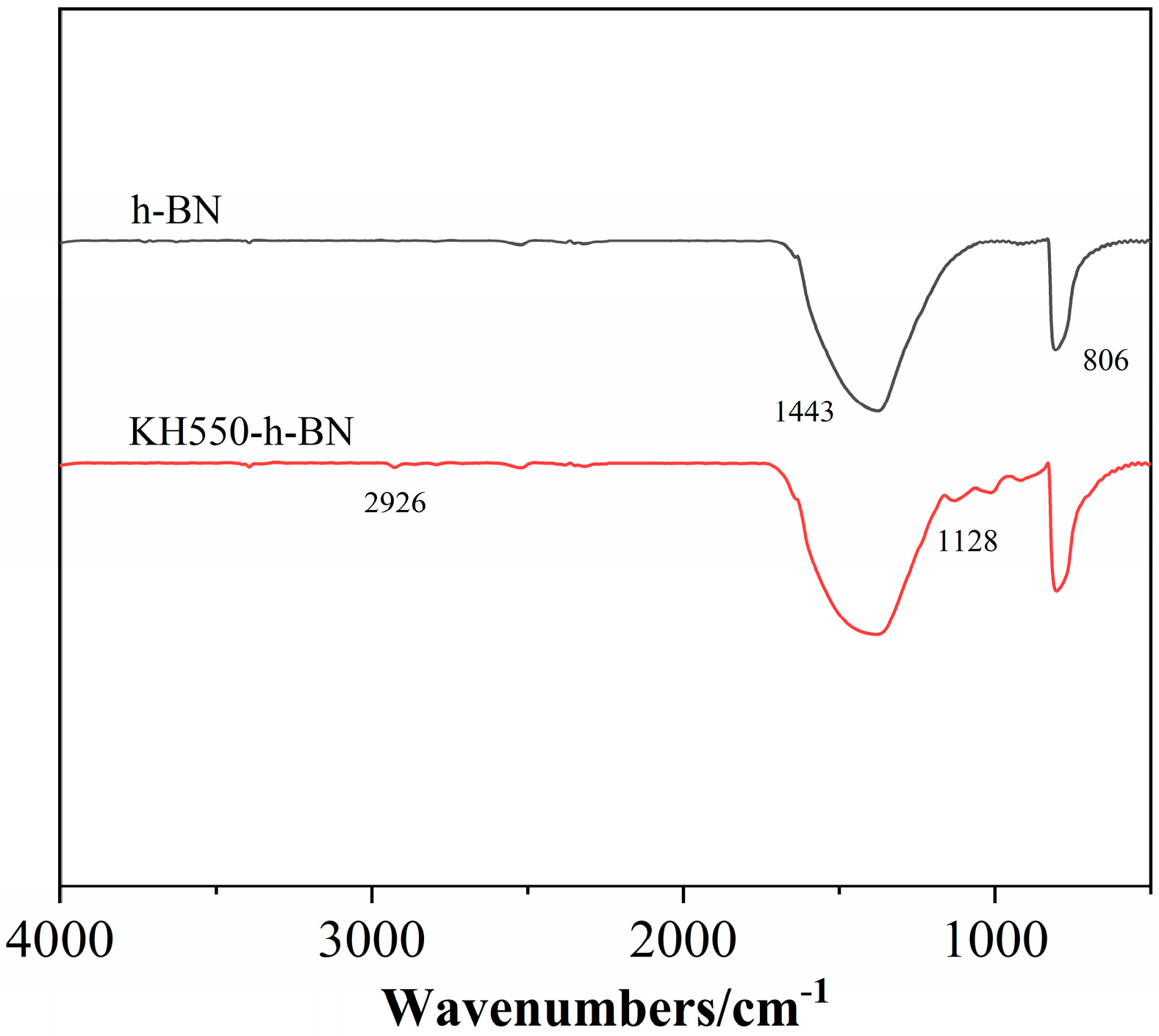
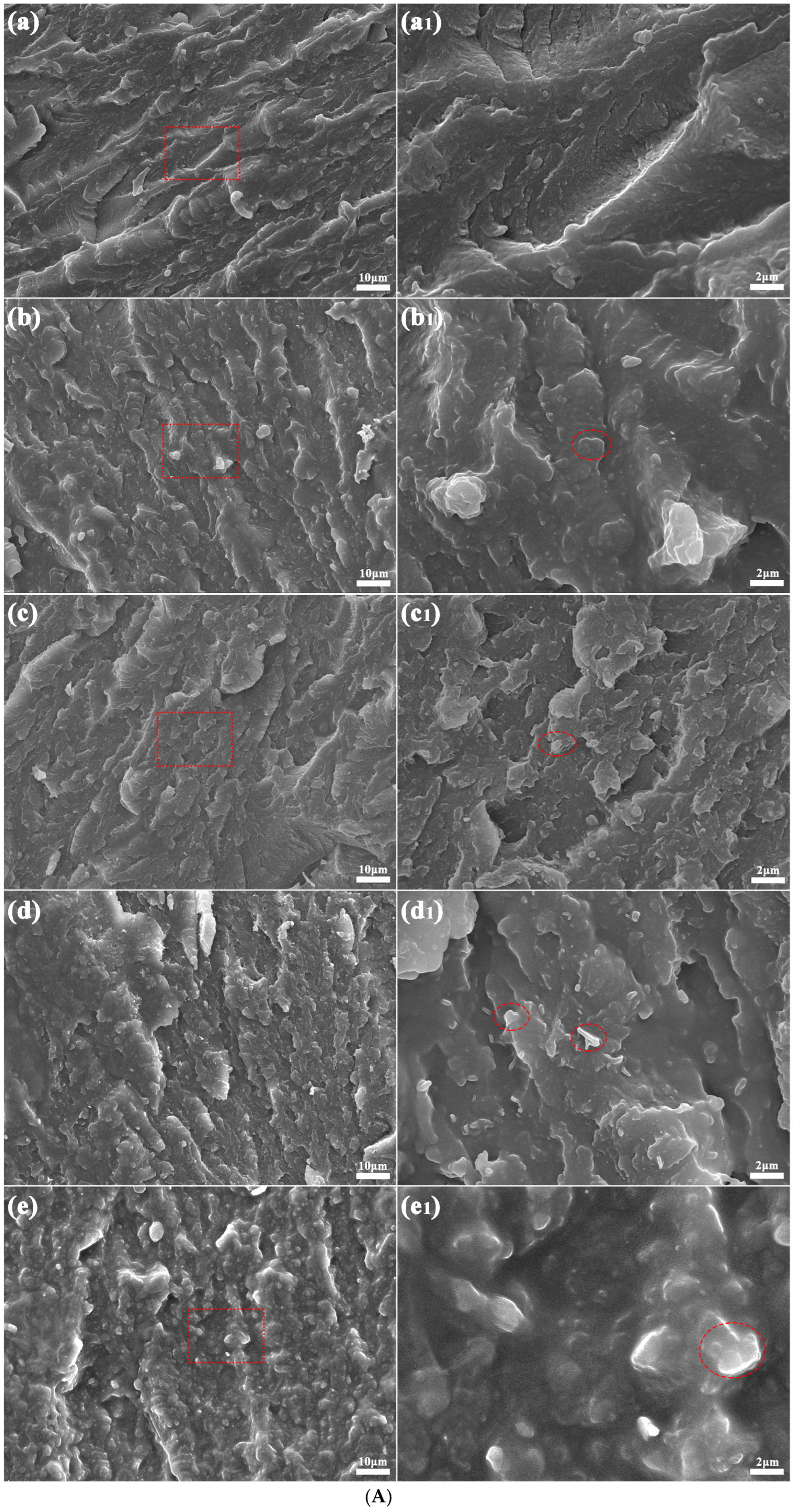
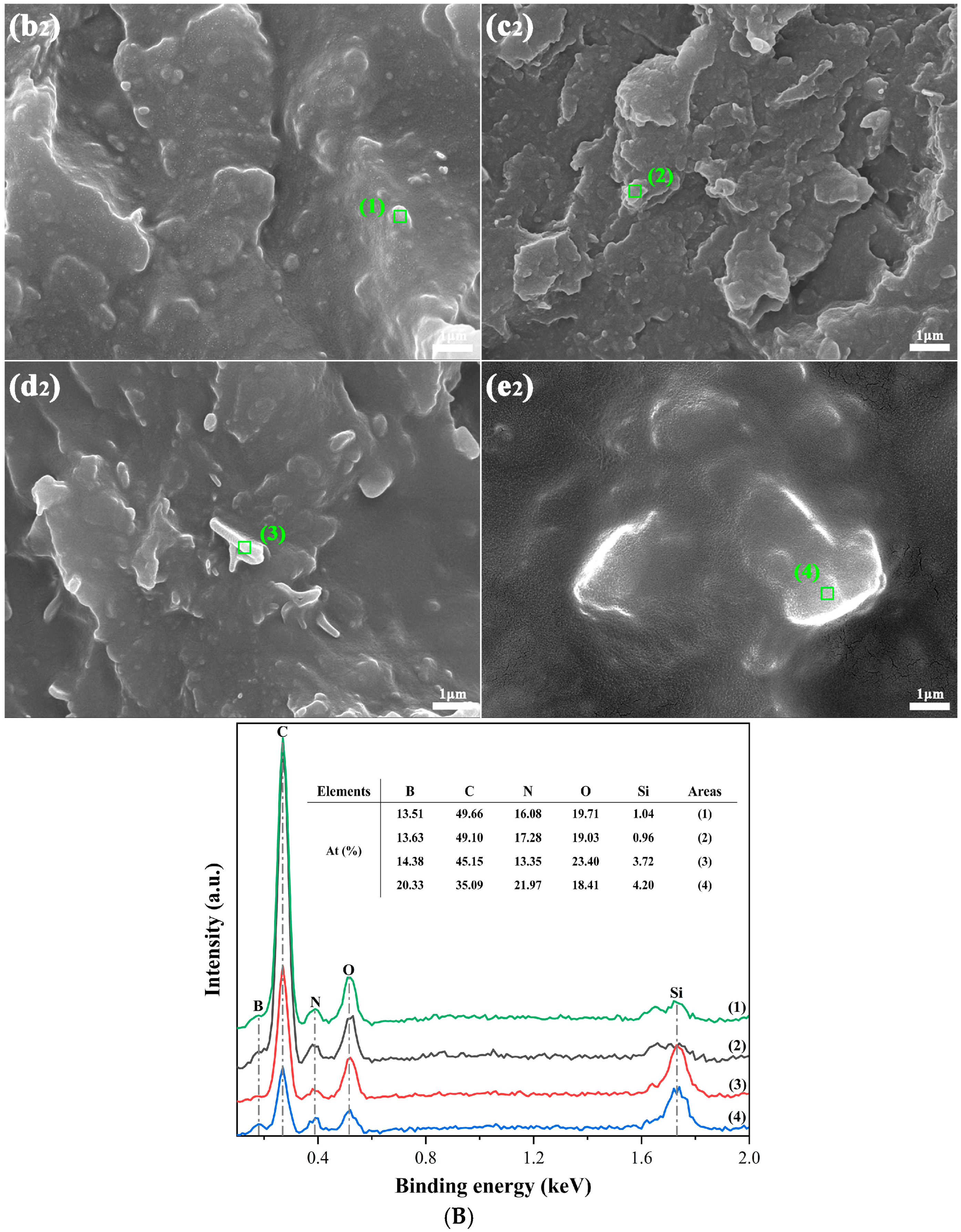

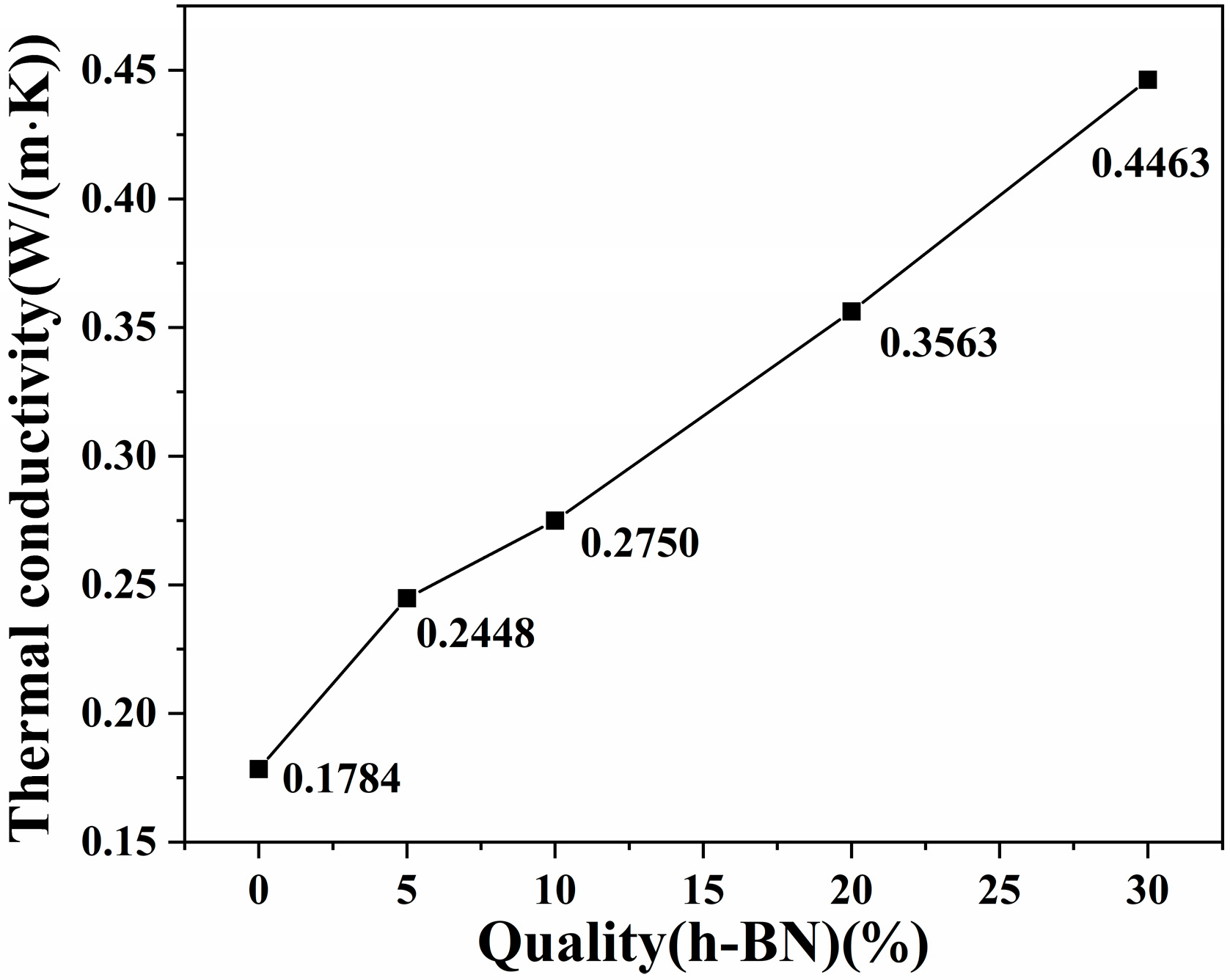
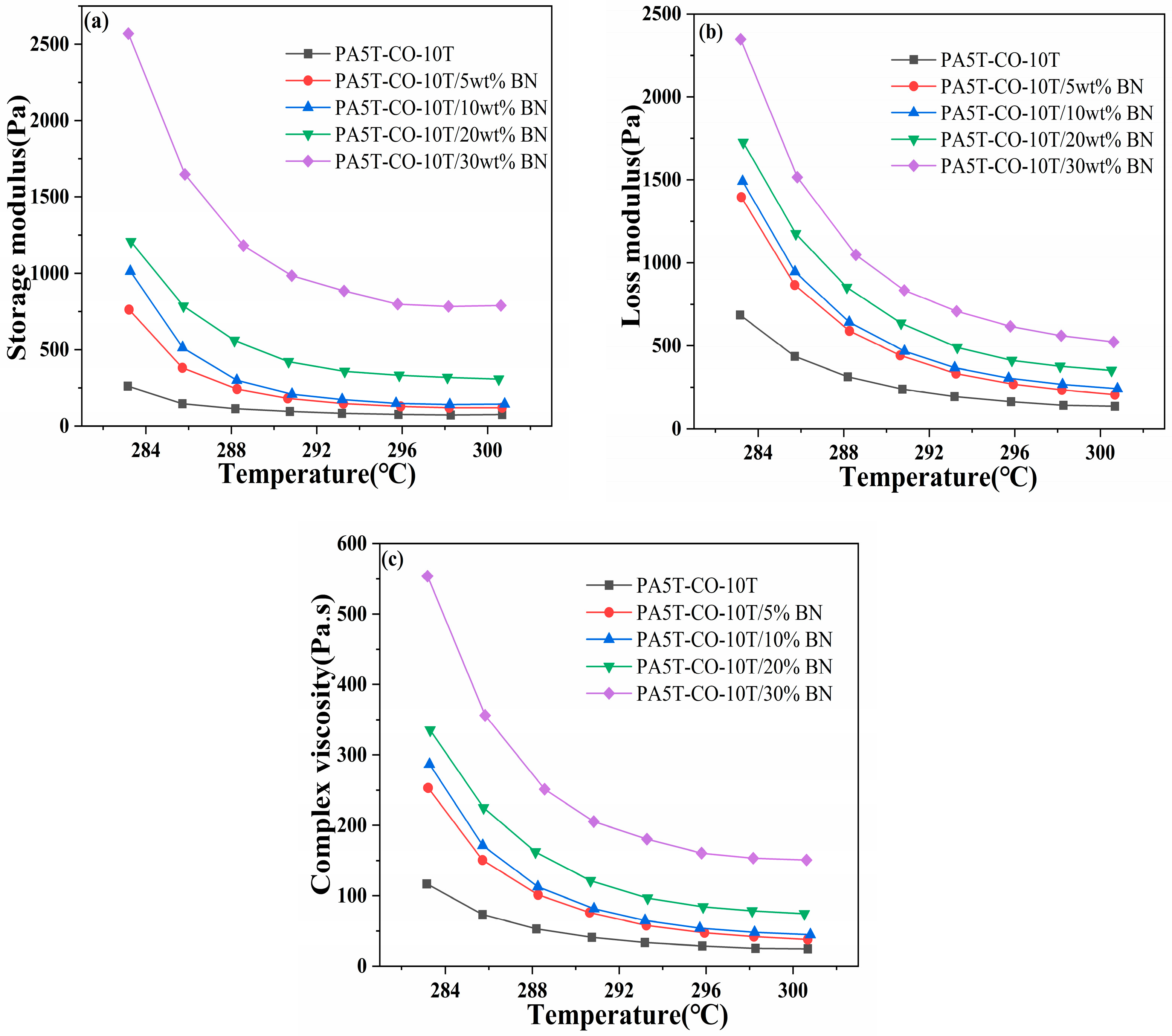
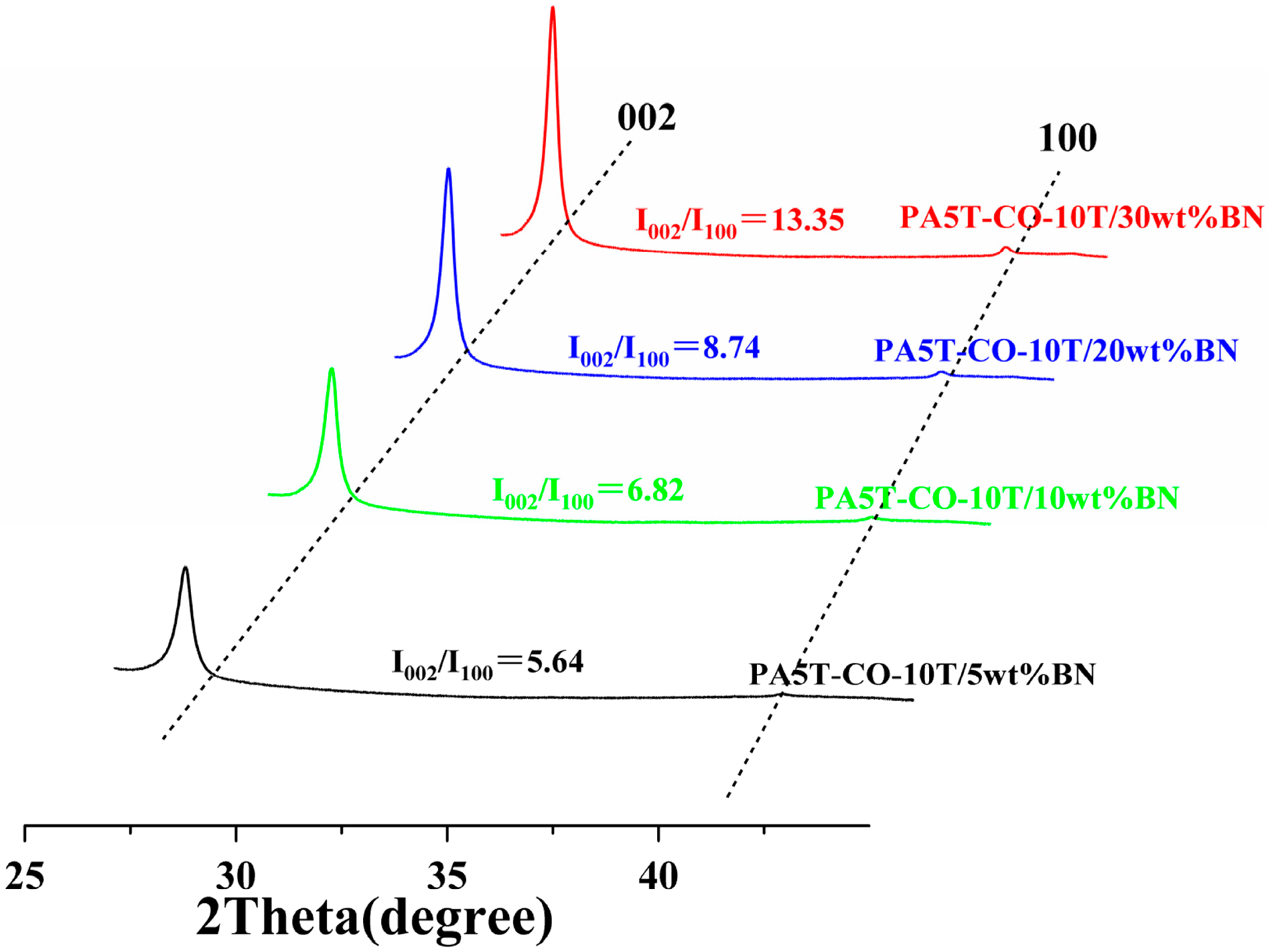
| Samples | PA5T-CO-10T wt% | h-BN wt% | Antioxidant 1010 wt% |
|---|---|---|---|
| PA5T-CO-10T | 97 | 0 | 3 |
| PA5T-CO-10T/5 wt%BN | 92 | 5 | 3 |
| PA5T-CO-10T/10 wt%BN | 87 | 10 | 3 |
| PA5T-CO-10T/20 wt%BN | 77 | 20 | 3 |
| PA5T-CO-10T/30 wt%BN | 67 | 30 | 3 |
Disclaimer/Publisher’s Note: The statements, opinions and data contained in all publications are solely those of the individual author(s) and contributor(s) and not of MDPI and/or the editor(s). MDPI and/or the editor(s) disclaim responsibility for any injury to people or property resulting from any ideas, methods, instructions or products referred to in the content. |
© 2025 by the authors. Licensee MDPI, Basel, Switzerland. This article is an open access article distributed under the terms and conditions of the Creative Commons Attribution (CC BY) license (https://creativecommons.org/licenses/by/4.0/).
Share and Cite
Liu, B.; Zhu, Y.; Yang, C.; Ma, L.; Zhang, F.; Hao, M.; Wang, Z.; Bai, L.; An, J.; Xiao, D. Study on the Preparation and Properties of Thermally Conductive Semi-Aromatic Heat-Resistant PA5T-CO-10T/ Hexagonal Boron Nitride Composites. Polymers 2025, 17, 1031. https://doi.org/10.3390/polym17081031
Liu B, Zhu Y, Yang C, Ma L, Zhang F, Hao M, Wang Z, Bai L, An J, Xiao D. Study on the Preparation and Properties of Thermally Conductive Semi-Aromatic Heat-Resistant PA5T-CO-10T/ Hexagonal Boron Nitride Composites. Polymers. 2025; 17(8):1031. https://doi.org/10.3390/polym17081031
Chicago/Turabian StyleLiu, Bingxiao, Yunzhen Zhu, Chen Yang, Liqun Ma, Fuchun Zhang, Mingzheng Hao, Zhongqiang Wang, Lizhen Bai, Jiale An, and Dongqi Xiao. 2025. "Study on the Preparation and Properties of Thermally Conductive Semi-Aromatic Heat-Resistant PA5T-CO-10T/ Hexagonal Boron Nitride Composites" Polymers 17, no. 8: 1031. https://doi.org/10.3390/polym17081031
APA StyleLiu, B., Zhu, Y., Yang, C., Ma, L., Zhang, F., Hao, M., Wang, Z., Bai, L., An, J., & Xiao, D. (2025). Study on the Preparation and Properties of Thermally Conductive Semi-Aromatic Heat-Resistant PA5T-CO-10T/ Hexagonal Boron Nitride Composites. Polymers, 17(8), 1031. https://doi.org/10.3390/polym17081031








